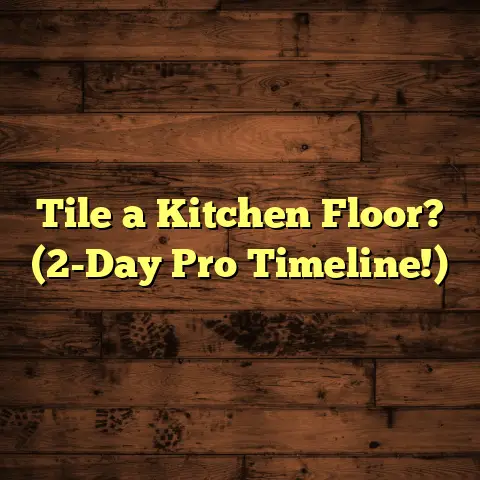How to Fix To Concrete? (4 Anchor Fails!)
Ever had that sinking feeling? Not just in your stomach, but in your concrete?
I’m talking about the kind you get when you realize that beautiful outdoor patio you built last summer is now sporting cracks radiating from where your pergola anchors used to be.
Yeah, I’ve been there.
Picture this: a sunny afternoon, kids laughing, burgers sizzling on the grill. Then bam! You notice the pergola’s leaning a little too far to the left.
A closer look reveals the horror: the concrete around the anchors is crumbling, the anchors themselves are loose, and your dream outdoor space is turning into a safety hazard.
Frustrating, right?
It’s more than just an eyesore. It’s a potential lawsuit waiting to happen, a hit to your property value, and a serious disruption to your outdoor living.
I’ve seen this happen more times than I can count. From swing sets threatening to topple to deck supports coming loose, anchor failure in concrete is a surprisingly common problem.
And trust me, ignoring it won’t make it go away.
So, what went wrong? And more importantly, how do you fix it?
Let’s dive in and figure out how to tackle these concrete catastrophes head-on!
Section 1: Understanding Concrete Anchor Failures
Okay, let’s get down to brass tacks. What are concrete anchors, and why do they fail?
Think of anchors as the unsung heroes of construction. They’re the things that hold everything together – literally.
We’re talking about securing everything from that fancy pergola to heavy machinery.
There are a ton of different types of anchors out there, but some of the most common I’ve worked with include:
-
Wedge Anchors: These guys are workhorses. You drill a hole, insert the anchor, and as you tighten the nut, a wedge expands, gripping the concrete. They’re great for medium to heavy loads.
-
Sleeve Anchors: Similar to wedge anchors, but with a sleeve that expands along its entire length for even more holding power.
-
Epoxy Anchors: For the big guns! These involve injecting epoxy into a drilled hole and then inserting a threaded rod. The epoxy bonds chemically to the concrete and the rod, creating an incredibly strong hold. I’ve used these for everything from securing heavy equipment to reinforcing bridge supports.
So, what makes these anchors pack their bags?
Well, it’s usually a combination of factors:
-
Improper Installation: This is HUGE. I’m talking wrong drill bit size, not cleaning the hole properly, over- or under-torquing the anchor. I’ve seen it all. A study by the Portland Cement Association found that up to 50% of anchor failures are due to improper installation. (PCA, “Concrete Anchors: A Guide to Selection and Installation,” 2018). It’s like baking a cake – you gotta follow the recipe!
-
Inadequate Load-Bearing Capacity: Using the wrong anchor for the job. Trying to hang a grand piano with a picture hook, basically. Each anchor has a specific load rating, and exceeding it is a recipe for disaster.
-
Environmental Conditions: Concrete expands and contracts with temperature changes. Moisture can seep in and corrode metal anchors. Freeze-thaw cycles can weaken the concrete around the anchor. All these things can lead to failure over time.
-
Age of Concrete: Concrete isn’t indestructible. Over time, it can weaken and crack, reducing the anchor’s holding power. Think of it like trying to screw into rotted wood – it just won’t hold.
Let me tell you about a job I did last year. A client had built a beautiful deck, but the posts were starting to wobble. Turns out, the original contractor had used the wrong type of anchors – simple lag shields – and hadn’t properly sealed them.
The moisture got in, corroded the anchors, and weakened the concrete. We ended up having to remove all the old anchors, patch the concrete, and install epoxy anchors with stainless steel rods. It was a pain, but it fixed the problem.
The moral of the story? Understanding how anchors work and what can cause them to fail is the first step in preventing – or fixing – a concrete anchor catastrophe.
Section 2: Identifying Signs of Anchor Failure
Alright, so how do you know if your anchors are about to betray you? Catching the signs early can save you a lot of headaches (and money).
Here’s what I look for on the job:
-
Cracks Radiating from the Anchor Site: This is the most obvious sign. If you see cracks spreading out from where the anchor is installed, it means the concrete is under stress and the anchor is likely pulling out. These cracks can be hairline fractures or full-blown fissures. Don’t ignore them!
-
Noticeable Movement or Shifting of the Attached Structure: If your pergola is swaying in the breeze more than usual, or your deck railing feels loose, it’s time to investigate.
-
Rust or Corrosion on Metal Anchors: Rust is the enemy of metal. It weakens the anchor and reduces its holding power. If you see rust, it’s a sign that moisture is getting in and the anchor is deteriorating.
-
Spalling Concrete: Spalling is when the concrete surface starts to flake or chip away. This is often caused by freeze-thaw cycles or corrosion of the reinforcing steel (if any) inside the concrete.
-
Anchor Pull-Out: This is the worst-case scenario. The anchor has completely pulled out of the concrete, leaving a gaping hole. This is a serious safety hazard and needs to be addressed immediately.
I always recommend doing regular inspections, especially for outdoor structures.
Here’s my step-by-step guide:
-
Visual Inspection: Start by simply looking at the concrete around the anchors. Are there any cracks, rust, or spalling?
-
Physical Check: Try to wiggle the attached structure. Does it feel loose or unstable?
-
Anchor Test: Gently try to wiggle the anchor itself. If it moves, it’s likely loose.
-
Sound Test: Tap the concrete around the anchor with a hammer. A solid sound indicates good concrete. A hollow sound suggests delamination or cracking.
-
Moisture Check: Look for signs of moisture around the anchor. This could indicate a leak or poor sealing.
Don’t be afraid to get down on your hands and knees and take a close look. A little preventative maintenance can save you a lot of trouble down the road.
Section 3: Repair Strategies for Failed Anchors
Okay, you’ve identified a failed anchor. Now what? Don’t panic! I’m going to walk you through the process of repairing the damage and getting your structure back on solid ground.
3.1: Removing Old Anchors
First things first, you gotta get that old anchor out. This can be tricky, especially if it’s rusted or stuck. Here’s what you’ll need:
-
Safety Glasses: Always protect your eyes!
-
Gloves: Protect your hands.
-
Hammer Drill: A must-have for concrete work.
-
Drill Bits: A variety of sizes, including a bit slightly smaller than the anchor diameter.
-
Punch: For driving out stubborn anchors.
-
Hammer: For hitting the punch.
-
Vice Grips or Pliers: For gripping and twisting the anchor.
-
Penetrating Oil: Like WD-40, to help loosen rusted anchors.
Here’s the step-by-step:
-
Assess the Situation: How stuck is the anchor? Is it rusted? Is the concrete around it damaged?
-
Apply Penetrating Oil: If the anchor is rusted, spray it with penetrating oil and let it soak for a few hours.
-
Drill a Pilot Hole: If the anchor is solid, drill a pilot hole through the center of the anchor using a drill bit slightly smaller than the anchor diameter. This will weaken the anchor and make it easier to remove.
-
Use a Punch and Hammer: Place the punch on the anchor and tap it with a hammer. The goal is to drive the anchor further into the hole, which will often break it free.
-
Grip and Twist: Use vice grips or pliers to grip the anchor and try to twist it out. If it’s really stuck, you may need to rock it back and forth to loosen it.
-
Drill Around the Anchor: If all else fails, use a hammer drill to carefully drill around the anchor, being careful not to damage the surrounding concrete too much.
-
Clean the Hole: Once the anchor is removed, clean the hole thoroughly with a brush and vacuum. Remove any loose debris or dust.
Important Note: If you’re dealing with a chemical anchor (epoxy), you may need to use a special solvent to dissolve the epoxy.
3.2: Assessing and Preparing the Concrete Surface
Now that the old anchor is gone, it’s time to assess the damage and prep the concrete for the new anchor.
Here’s what you’ll need:
-
Wire Brush: For cleaning the concrete surface.
-
Concrete Patching Compound: For filling cracks and holes.
-
Trowel: For applying the patching compound.
-
Concrete Grinder (Optional): For smoothing the surface.
-
Concrete Sealer: To protect the concrete from moisture.
Here’s the process:
-
Clean the Surface: Use a wire brush to remove any loose debris, dirt, or oil from the concrete surface.
-
Assess the Damage: Look for cracks, holes, or spalling.
-
Patch Cracks and Holes: Mix the concrete patching compound according to the manufacturer’s instructions. Apply the compound to the cracks and holes using a trowel. Smooth the surface and let it cure according to the manufacturer’s instructions.
-
Grind the Surface (Optional): If the surface is uneven, use a concrete grinder to smooth it out.
-
Clean Again: Once the patching compound is cured, clean the surface again with a wire brush and vacuum.
-
Apply Concrete Sealer: Apply a concrete sealer to protect the concrete from moisture and prevent future damage.
Pro Tip: For larger cracks or holes, you may need to use a concrete bonding agent to ensure that the patching compound adheres properly to the existing concrete.
3.3: Selecting the Right Replacement Anchors
Choosing the right anchor is crucial for a long-lasting repair. Consider these factors:
-
Load Requirements: How much weight will the anchor need to support?
-
Concrete Type: Is the concrete cracked, weak, or new?
-
Environmental Conditions: Will the anchor be exposed to moisture, chemicals, or extreme temperatures?
Here’s a quick guide:
-
Light Loads: Sleeve anchors or small wedge anchors.
-
Medium Loads: Wedge anchors or expansion bolts.
-
Heavy Loads: Epoxy anchors or large diameter wedge anchors.
-
Cracked Concrete: Specialty anchors designed for cracked concrete, such as undercut anchors or post-installed rebar.
-
Corrosive Environments: Stainless steel anchors or epoxy-coated anchors.
Don’t skimp on quality! Buy your anchors from a reputable supplier and make sure they meet the required standards. I’ve seen too many folks try to save a buck only to have their anchors fail again a few months later.
3.4: Installing New Anchors
Alright, you’ve got your new anchors and the concrete is prepped. Time to get drilling!
Here’s what you’ll need:
-
Hammer Drill: Again, a must-have.
-
Drill Bits: The correct size for your anchors.
-
Torque Wrench: For tightening the anchors to the correct torque.
-
Cleaning Brush: For cleaning the drilled holes.
-
Vacuum: For removing dust from the holes.
-
Epoxy (If Using Epoxy Anchors): The correct type for your anchors and the concrete.
Here’s the process:
-
Read the Instructions: Follow the manufacturer’s instructions for installing your specific type of anchor.
-
Drill the Hole: Use a hammer drill and the correct size drill bit to drill the hole to the required depth.
-
Clean the Hole: Use a cleaning brush and vacuum to remove all dust and debris from the hole. This is crucial for proper anchor performance.
-
Insert the Anchor: Insert the anchor into the hole.
-
Tighten the Anchor: Use a torque wrench to tighten the anchor to the correct torque specified by the manufacturer. Don’t over-tighten!
-
For Epoxy Anchors: Inject the epoxy into the hole according to the manufacturer’s instructions. Insert the threaded rod and let the epoxy cure for the specified time.
Important Tips:
-
Drill Straight: Make sure you drill the hole straight and perpendicular to the concrete surface.
-
Clean Thoroughly: Cleaning the hole is essential for proper anchor performance.
-
Use the Right Torque: Over-tightening or under-tightening can both lead to anchor failure.
3.5: Testing Stability Post-Repair
After you’ve installed the new anchors, it’s important to test their stability before putting any weight on them.
Here’s how I do it:
-
Visual Inspection: Double-check that the anchors are properly installed and tightened.
-
Wiggle Test: Try to wiggle the attached structure. It should feel solid and stable.
-
Load Test: Gradually apply weight to the structure and observe the anchors. Look for any signs of movement or cracking.
-
Pull Test (Optional): For critical applications, you can perform a pull test using a hydraulic pull tester. This will measure the actual pull-out strength of the anchors.
If you’re not comfortable performing these tests yourself, hire a qualified engineer to do it for you. It’s better to be safe than sorry.
Section 4: Preventive Measures to Avoid Future Anchor Failures
Okay, you’ve fixed your anchor failure. Now, let’s talk about how to prevent it from happening again.
Here are some proactive strategies:
-
Choose the Right Anchor: As we discussed earlier, selecting the correct anchor for the application is crucial. Consider the load requirements, concrete type, and environmental conditions.
-
Proper Installation: Follow the manufacturer’s instructions carefully. Don’t cut corners!
-
Regular Maintenance: Inspect your anchors regularly for signs of corrosion, cracking, or loosening.
-
Seal the Concrete: Apply a concrete sealer to protect the concrete from moisture and prevent future damage.
-
Avoid Overloading: Don’t exceed the anchor’s load rating.
-
Consider Environmental Factors: In areas with extreme temperatures or freeze-thaw cycles, use anchors that are designed to withstand these conditions.
-
Consult a Professional: If you’re not sure how to install an anchor properly, or if you have any concerns about the structural integrity of your concrete, consult a qualified engineer or contractor.
I had a client who lived near the coast. The salty air was wreaking havoc on their outdoor structures. We ended up replacing all their galvanized steel anchors with stainless steel anchors and applying a special marine-grade coating to the concrete. It was a bit more expensive upfront, but it saved them a lot of money in the long run.
Conclusion
Fixing concrete anchor failures can seem daunting, but with the right knowledge and tools, it’s definitely achievable.
Remember to:
-
Understand the different types of anchors and how they work.
-
Identify the signs of anchor failure early.
-
Follow the proper repair procedures.
-
Take preventive measures to avoid future failures.
Don’t underestimate the importance of addressing anchor failures promptly. They can compromise the safety and integrity of your structures and lead to costly repairs down the road.
So, take action! Apply the knowledge you’ve gained from this article to ensure that your concrete installations remain secure and reliable for years to come.





